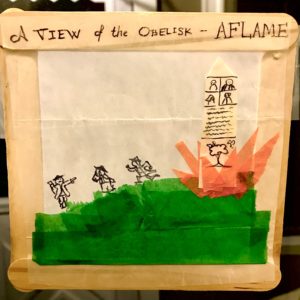Illuminating the Past: Create Your Own Historic Window Display!
By: Kristin Peszka
 Before electricity, nights were long and dark. While Boston was early to employ rudimentary lighting at main thoroughfares from fire baskets on poles lit by the night watchman, widespread use of gas street lights did not occur until about a half century after the Revolution. Candles were costly and dangerous, so they were used sparingly most of the time, but at times of celebration, fireworks, candles, bonfires, lanterns, and other illuminations lit up the night.
Before electricity, nights were long and dark. While Boston was early to employ rudimentary lighting at main thoroughfares from fire baskets on poles lit by the night watchman, widespread use of gas street lights did not occur until about a half century after the Revolution. Candles were costly and dangerous, so they were used sparingly most of the time, but at times of celebration, fireworks, candles, bonfires, lanterns, and other illuminations lit up the night.
“Illuminations” from public celebrations that were described in colonial letters or newspapers could have been anything from candles in windows to elaborate art installations. They appeared at a variety of events and must have been very impressive. Imagine the sight of the obelisk designed by Paul Revere for the repeal of the Stamp Act: a large structure reportedly lit from within by 280 lanterns!
One of colonial Boston’s most intriguing examples of an illumination was a window display created by Paul Revere to commemorate the first anniversary of the Boston Massacre. As Boston grew dark, thousands of people came to North Square to see the solemn exhibition at Revere’s home. The Paul Revere House commissioned artist R.P. Hale to re-imagine this display for the 250th anniversary on March 5, 2021.
We don’t know exactly how Revere created his displays. They were likely made of oiled paper fastened to a frame. The oil would make the paper translucent so pictures drawn on it would be seen clearly when lit from behind.
While we do not know precisely what process Revere went through, the good news is that you can create your own window illuminations! You can use them for a celebration or to share a message with your neighborhood. They will glow at night when your lights are on and when the sun shines through them in the day. Though there are a quite a few ways to achieve the effect, we’ll skip the oil and fire and go for something a bit less messy (and less dangerous! The obelisk went up in flames on Boston Common, even before they could light the attached fireworks).
Materials: You’ll need a paper base, something to make the frame, something for decorating, and something to stick it all together. Take a look around the house for the supplies and experiment with what you have at hand. Be creative, like Paul Revere!
Frame: 4 popsicle sticks, bamboo skewers, or straight sticks from outside.
Translucent paper: Try tracing paper, tissue paper, parchment paper, waxed paper from the kitchen, or transparency sheets. Even the glassine paper envelope they put stamps in at the post office worked great!
Decorating: Tissue paper and glue stick, markers, translucent paints. You’ll have to find out what works with the paper you have. Sharpies mark on waxed paper or transparency sheets, but ordinary markers don’t.
Glue: Ordinary school glue for the frame or tape might work on some paper, glue stick works best on tissue paper.
Directions:
1) Stick your four sticks together to make a square frame and let dry.
2) Stick your paper into the frame, trim off the edges, and let dry.
3) Practice your designs while the glue dries. You can trace your best drawing onto the paper when it’s ready.
4) For a great look, add color by gluing on bits of tissue paper. You can try to add details with a marker.
5) Hang your finished art in the window so thousands of people can see it!
Kristin Peszka is the Visitor Services Director at the Paul Revere House
